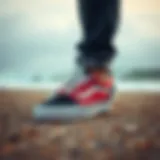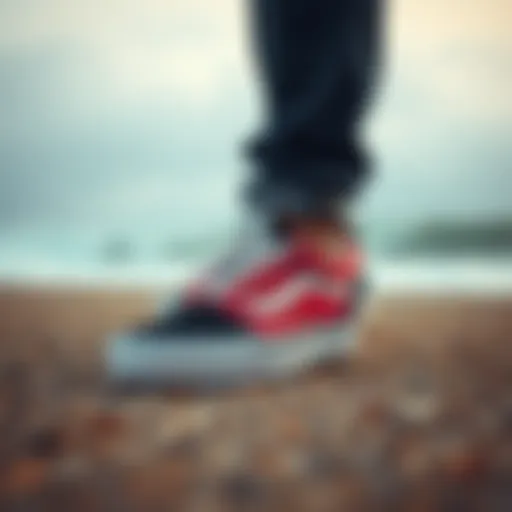The Impact of GoPro on Surfboard Culture and Photography
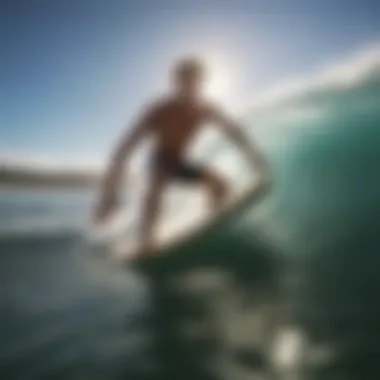

Intro
The synergy between surfing and technology has reached new heights with the advent of compact cameras like GoPro. These devices have not only revolutionized how surfers document their experiences but have also influenced the culture surrounding this thrilling sport. This article seeks to uncover the impact of GoPro on surf culture while examining effective techniques for integrating these cameras into surfboards. By exploring both the artistic and practical aspects of capturing surf photography, we aim to provide a well-rounded perspective on this modern phenomenon.
Surfing Techniques
Surfing, at its core, is an intricate dance between skill, nature, and equipment. With GoPro seamlessly integrated into surfboards, capturing the essence of each ride requires a unique approach. This section offers insights into techniques for both beginners and seasoned surfers.
Advanced Maneuvers for Experienced Surfers
Experienced surfers often push the envelope, seeking to capture jaw-dropping images. Here are some advanced techniques that can amp up your footage:
- Aerials: Executing a well-timed aerial maneuver not only looks stunning but also showcases the skill of the surfer. For these shots, positioning the camera at the right angle is critical.
- Tube Riding: Riding inside the wave, or getting "tubed," presents a unique opportunity for impressive footage. Ensure the camera is secure on the board, so it captures the thrill of the ride without losing stability.
- Carves and Turns: Dynamic turns can create exciting visual sequences. A GoPro mounted on the front of the board can capture the sharpness of each maneuver.
Beginner Tips for Catching Your First Wave
For those just starting out, the integration of GoPro technology can enhance the learning experience:
- Secure Your Gear: Ensure that your GoPro is firmly attached to your board to avoid any mishaps. A quality mount can keep your camera safe while you focus on catching your first wave.
- Choose the Right Waves: Look for smaller waves to practice on. When you're comfortable, it’ll be easier to capture your experience on camera.
- Document Your Progress: Recording your surfing sessions can give you invaluable feedback. Watch your footage to identify areas to improve, like your paddling technique or balance.
- Share Your Journey: Use social media platforms such as Reddit or Facebook to showcase your achievements. Sharing your progress can also connect you with other beginner surfers and provide emotional encouragement.
"The combination of adrenaline and creativity is what makes surfing with a GoPro so captivating. It's like painting each wave with your own brush."
In the world of surfboarding, the balance between effort and adventure is paramount. With GoPro cameras, the quest for capturing unforgettable moments surges to the forefront of surf culture. Surfboards are no longer merely a means to an end, but rather a canvas for storytelling through visual media. As we delve deeper into the characteristics of gear and equipment in the next section, we’ll examine how the right setup can elevate the surf experience even further.
Prologue to GoPro in Surfboarding
In recent years, the fusion of technology and adventure has become increasingly prominent, particularly with the advent of portable cameras. GoPro has carved out a special niche in surfboarding culture, enabling enthusiasts to capture their thrilling experiences both in and out of the water. This integration is not merely an enhancement of existing practices; rather, it's a transformative approach that redefines how surfers interact with their sport and their audience.
Integrating a GoPro into surfboarding has opened up a plethora of possibilities for surfers. It allows for real-time footage of rides, showcasing not just the beauty of the waves, but also the skill and artistry of the surfer. This is not just about keeping memories; it’s about sharing those moments with a wider audience. Nowadays, a stellar ride can be instantly broadcast to friends, family, or even the surfing community at large.
Some benefits stand out when discussing the significance of GoPro in this context:
- Visual Storytelling: Surfers can convey their adventures in vivid detail, crafting compelling narratives that resonate with viewers.
- Skill Development: Capturing sessions on video allows individuals to review their technique, identify areas for improvement, and thus enhance their surfing prowess.
- Community Connection: By sharing footage online, surfers cultivate relationships with others, fostering a sense of community through shared experiences.
However, integrating GoPro technology also brings its own set of considerations. For surfers, there can be a temptation to focus more on capturing the moment rather than enjoying it. The balance between recording and experiencing must be carefully managed. Concerns about equipment safety and longevity also come into play; it’s vital to ensure that cameras are well mounted and protected from the harsh surf environment.
Ultimately, understanding the role of GoPro in surfboarding culture involves recognizing both the thrilling perks and the subtle potential pitfalls. As we explore this topic deeper, we will discuss how to choose the right GoPro model, effective mounting strategies, and editing footage, ensuring every surfer can harness this technology to elevate their connection with both the waves and their audience.
The Evolution of Surfing Technology
In the realm of surfing, embracing technology has reshaped not only the way surfers capture their exhilarating rides but also how they experience their sport. The intersection of surfing and technology has undergone significant changes, serving as a cornerstone for the modern surf culture. Understanding the evolution of this technology is essential, as it highlights the innovative spirit that defines the surfing community. This evolution focuses on creating gear that enhances performance while increasing the appeal of surfing to a wider audience.
Surfers today benefit from advancements that provide better safety, more enjoyable experiences, and more ways to engage with the sport's vibrant community. As we delve deeper, it becomes clear that the rise in technological tools has allowed surfers to document their journeys, contributing to a collective culture based around shared experiences and showcasing unique perspectives.
Advancements in Camera Technology
The advent of more sophisticated camera technology has dramatically transformed how surfers capture their experiences. Gone are the days of bulky cameras and cumbersome setups. Instead, the development of light, compact cameras has paved the way for a new wave of photographic innovation.
Digital photography, coupled with improvements in high-definition video capability, has made capturing those thrilling moments on the water both accessible and compelling. With sharp imagery and vibrant colors, surfers can now relive their triumphs in unprecedented detail.
Some key advancements include:
- Higher Resolution: Cameras now support ultra-high-definition (UHD), allowing image quality that brings the intricate details of each wave to life.
- Improved Low-light Performance: Modern sensors are better at capturing footage during dawn or dusk, providing flexibility for surf sessions in various lighting conditions.
- Built-in Stabilization: Enhanced software helps reduce shaky footage, making even the most dynamic rides look professional.
These advancements not only enhance the visual representation of surfing but also encourage creativity among surfers as they experiment with various filming techniques.
Rise of Action Cameras
The popularity of action cameras like GoPro has truly revolutionized surf filming. These compact devices are waterproof, rugged, and versatile, designed to withstand the challenges of vibrant aquatic environments. Surfers can now mount these cameras securely on their boards or wear them for POV shots, capturing every splash and turn from a personal viewpoint.
- Ease of Use: Action cameras are user-friendly, making it simple even for amateurs to hit the button and get going.
- Variety of Mounting Options: From chin mounts to wrist straps, the possibilities for angle and perspective are virtually limitless, providing a range of creative options previously unavailable.
- Sharing Capabilities: With integrated Wi-Fi, many of these cameras allow direct sharing of content to social media, making it effortless to connect with friends, family, and followers.
This rise of action cameras has not just influenced how surfers film—it's also changed what they choose to film. Surfers now want not just to catch the perfect wave but also to document their journeys in a way that reflects their personality and style.
Choosing the Right GoPro Model for Surfing
Selecting the right GoPro model for surfing is no small feat. Each model comes packed with unique features and capabilities that can make or break your surf video. The thrill of riding a wave can be spectacular, but capturing that moment requires the right equipment. A poor choice in camera can lead to lackluster results or even missed experiences. Understanding your needs and knowing the ins and outs of each model goes a long way toward helping you achieve the best surf footage possible. From stunning resolution to prolonged battery life, the choices you make here are pivotal.
Comparison of GoPro Models
Hero Series
The Hero Series has long been a staple for surfers. Its widespread popularity stems from its versatility and user-friendly design. The key characteristic of this series is its robust build quality. Surfers often find this model to be beneficial when faced with harsh saltwater conditions. One feature that stands out in the Hero Series is its Hypersmooth stabilization, which helps deliver smooth footage even during turbulent moments on the waves. However, it does come with a drawback; while its resolution can reach high levels, certain older models in the series may not handle low-light conditions as well as newer options.
Max Series
The Max Series takes action camera technology a step further. It is renowned for being a 360-degree camera, which offers a completely immersive experience. This is especially beneficial for surf enthusiasts who want to capture the surf scene from any angle imaginable. However, while the Max delivers a unique viewing experience, it's crucial to note that editing the footage can be more complex and may require additional software knowledge. This camera shines when it serves as a device for producing engaging, multidimensional content that makes the viewer feel right in the surf.
Special Features
The special features of GoPro cameras can greatly enhance the surf video experience. A prominent characteristic is the Voice Control feature, allowing surfers to capture shots hands-free—making it seamless to shoot while balancing on a board. This capability is particularly beneficial in the fast-paced environment of surfing, as it often doesn’t allow for quick adjustments. However, reliance on voice commands may be a bit tricky in noisy beach conditions, which can hinder its effectiveness. Overall, though, these special features help elevate the user experience, enabling surfers to focus on what they do best—ride the waves.
Understanding Specifications
Resolution
Resolution lays the groundwork for video quality. It determines how clear and detailed your footage will be. The most common resolutions available in GoPro models include 1080p and 4K. A higher resolution is typically seen as advantageous, as it captures more detail, allowing viewers to immerse themselves in the action. However, higher resolutions also consume more storage and battery life, so it's essential to weigh this against how much footage you intend to capture.
Frame Rate
The frame rate is another critical factor in producing crisp and fluid surfing videos. The GoPro allows different frame rates, with 60 frames per second (fps) being a good middle ground for most surf scenarios. Higher frame rates can be beneficial for slow-motion footage, making the action seem more dramatic. However, the trade-off often involves larger file sizes, so checking storage capabilities before a surf session can be worthwhile.
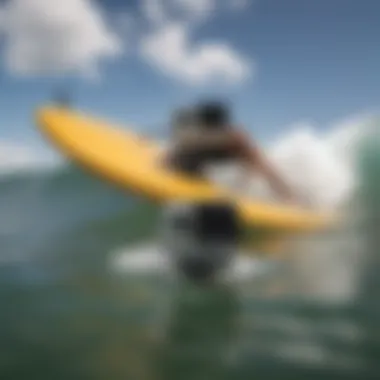

Battery Life
Lastly, battery life can quickly become a concern when you’re out on the water. It's a wise move to choose a model with solid battery endurance, particularly if you’re planning to shoot all day. Many surfers carry backup batteries to mitigate this issue, aiming for models that offer quick charging options, which can save time between sessions. Ensuring you can keep shooting without constantly worrying about running out of juice is key to capturing those unforgettable moments.
Mounting a GoPro on a Surfboard
Mounting a GoPro on a surfboard is critical for capturing the thrill of surfing in a way that stills can’t quite manage. It’s about more than just sticking a camera to your board; it’s about immersing viewers in the experience. A well-mounted GoPro can provide an unobstructed view of the waves, the rider, and the sheer adrenaline that comes with each ride. It enhances storytelling, bridging the gap between the surfer and the viewer. Plus, with the evolution of surfboarding technology, knowing how to effectively mount a GoPro can elevate your footage from good to show-stopping.
Types of Mounts
Adhesive Mounts
Adhesive mounts are perhaps the most straightforward solutions for attaching a GoPro to a surfboard. These mounts are designed with a strong adhesive backing that can withstand the rigors of ocean water and speed. The key characteristic of adhesive mounts is their low profile, keeping the camera close to the board's surface to minimize drag. This makes them particularly beneficial for surfers looking for a seamless setup.
The unique feature of adhesive mounts is that they can be placed in various positions on a board, allowing you to change angles without removing the mount itself. However, while they offer a strong bond, they can be tough to remove. There’s a risk of damaging the board’s surface, which leads to the main consideration: once you stick it on, it’s tough to take off without a fight.
Strap Mounts
Strap mounts are another popular choice, especially among those who want flexibility. These mounts use adjustable straps to secure the camera onto the board. This is particularly handy for surfers who might be experimenting with different angles or who want to share equipment among friends. The main advantage of strap mounts is their versatility.
Strap mounts can easily be taken off and repositioned. Additionally, they offer a comfortable fit, allowing a bit of give when riding the waves. However, the downside is that they can be bulkier compared to adhesive mounts. Under heavy wave impacts, they might shift slightly or even come loose, which could ruin a perfect shot.
Custom Solutions
Custom solutions can often provide the best experience as they are tailored to individual preferences. This could involve 3D-printed mounts or other modifications made from materials designed to endure action, alongside offering optimum placements. What makes customized mounts stand out is the personal touch they provide, allowing surfers to experiment until they find the perfect arrangement.
However, it’s essential to have some technical knowledge or to collaborate with someone skilled in design and fabrication. The primary advantage here is that custom solutions can integrate perfectly with unique board designs and the surfer's style. That said, the downside stems from cost and time; they can be more expensive and not always quick to develop.
Best Practices for Mounting
Placement Tips
Positioning your GoPro correctly is half the battle. The placement of the camera can make or break the footage quality. Ideally, surfers should mount the camera in a way that emphasizes the action they want to capture, be it from the nose of the board or at an angle that showcases the wave's power. This is crucial for conveying the thrill of each ride to viewers.
The best characteristic of strategic placement is that it can drastically change the footage's dynamic. A well-placed camera offers a natural perspective, making the audience feel like they’re part of the action. Perhaps one could argue that angling the camera slightly upward can create a more dramatic shot, capturing not just the wave but more of the environment around. However, there’s always a risk of capturing too much or too little, making adjustments necessary.
Safety Considerations
When it comes to surfboards, safety shouldn’t be an afterthought. Using a GoPro presents some unique safety challenges, especially considering that equipment can cause a hazard in heavy surf. While mounting tech can enhance picture quality, avoiding sharp edges or protruding mounts is essential to prevent potential injuries while riding.
The primary characteristic here is ensuring that the mounting does not compromise the surfer's safety. This also extends to the camera itself—if it detaches during a wipeout, it can become a projectile, posing risks to both the surfer and bystanders. Keeping the camera secure is important for showcasing the action without jeopardizing safety.
Techniques for Capturing Surf Action
Capturing the thrills of surf action presents unique challenges and rewards. It’s not just about having a GoPro glued to a surfboard; it’s about enhancing the experience, narrating the ride, and conveying the adrenaline of the sport. Effective techniques are paramount as they lay the foundation for breathtaking visuals that can leave viewers in awe. Getting the angles right, adapting to various conditions, and matching the right settings to each wave can pivot a good video into a great one.
Angles and Perspectives
Water Shots
Water shots refer to capturing images while the camera is submerged or just above the surface of the water. This technique produces stunning visuals that draw viewers into the ocean, giving them a sense of being part of the action. The clarity of a GoPro underwater allows for striking captures of both surfers and marine life.
One key characteristic of water shots is the unique perspective they offer – it’s not just about the surfer cutting through the waves but also the natural beauty surrounding them. This perspective has become increasingly popular among surf videographers, as it creates a dramatic flair, heightening the viewer’s emotional connection to the sea. However, a downside is the potential for water distortion, which can occasionally muddy the visuals. Still, the benefits often outweigh these drawbacks.
Aerial Views
Aerial views capture the surfer from above, often using a drone or a mounted GoPro on a pole. This perspective emphasizes the rhythm of the waves and the overall landscape, providing a broader context that water shots can’t achieve. One of the standout features of aerial views is how they encapsulate the entirety of the surfing experience – from the swirling sea to the distant shore.
The appeal of aerial views lies in their ability to depict scale and movement, painting a larger story. This type of shot can make a surfer appear tiny against massive waves, highlighting not just the sport's thrill but the ocean's grandeur. Yet, capturing aerial footage may require more expertise and equipment, potentially complicating the shooting process.
Timing and Settings
Getting the timing and settings right is crucial for delivering impactful surf action footage. It’s not enough just to point and shoot; knowing when to hit that record button can be the difference between a dull clip and an electrifying moment frozen in time.
Shutter Speed
Shutter speed controls how long the camera's sensor is exposed to light. Adjusting shutter speed is important when capturing fast-moving subjects like surfers slicing through waves. A fast shutter speed can freeze action, ensuring clarity in fast-paced scenes.
A key advantage is the sharpness it provides during dynamic movements. However, too fast of a shutter speed can lead to darker footage because not enough light hits the sensor, making it less ideal under certain conditions. Hence, balancing shutter speed with the ever-changing light is a vital skill for surf videographers.
Lighting Conditions
Lighting conditions can significantly affect image quality, especially for outdoor activities like surfing. Morning or late afternoon light provides warm tones and shadows that can enhance the visual appeal of the footage. On the contrary, harsh midday sunlight can wash out colors, making it tricky to capture nuanced details in the surf.
Understanding these lighting conditions is a game-changer. When a shooter figures out how to manipulate these variables, they can truly elevate their work. The challenge lies in predicting changes brought on by cloud cover or moving into shaded areas. Mastery of lighting allows surfers to not just catch waves but also capture them with artistry and finesse.
"The best surf footage doesn’t just show the wave; it tells a story of adventure, skill, and nature's brilliance."
Editing Surf Footage
Editing surf footage is more than just piecing together clips; it’s about crafting a narrative that reflects the thrill and beauty of the ocean. Surfing is not just a sport; it’s a lifestyle, and how you edit your footage plays a crucial role in conveying this ethos. Well-edited videos can ignite that fiery passion in viewers, transport them to the waves, and it can even inspire them to take the plunge into surfing themselves. Knowing how to edit effectively will save time and avoid stress when trying to capture the right mood; focusing on specific elements like software choice and techniques makes this process smoother and more enjoyable.
Software Choices
When it comes to editing surf footage, selecting the right software is pivotal. Different tools cater to varying levels of skill, budget constraints, and desired outcomes. Let's delve into some prominent software options.
GoPro Quik
GoPro Quik is designed for the surf community. It's user-friendly and integrates seamlessly with GoPro cameras. One of the most loved features is its ability to automatically analyze your footage and create stylish edits in a jiffy. This means even those who aren’t tech-savvy can produce quality videos without breaking a sweat.
However, it has its limitations. For instance, while Quik is great for quick edits, it lacks the depth of more advanced software. Users seeking intricate edits or more control over their projects might find it somewhat restrictive. Still, for a quick share to social media, it's tough to beat!
Adobe Premiere Pro
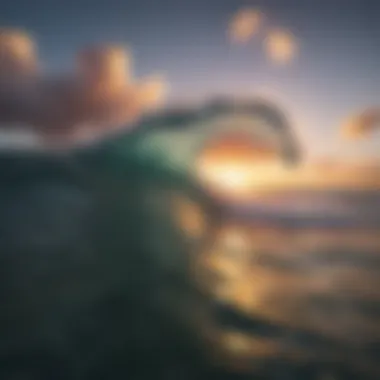

Adobe Premiere Pro is a veteran in the editing field, beloved by professionals. Its versatility allows for detailed customization—from fine-tuning sound to adding complex effects. The key characteristic that stands out is its comprehensive range of editing tools. This software is beneficial for deeper projects that require a bit of grit.
But it comes with a price, both financially and in terms of the learning curve. Newbies might find it initially daunting. But once you master it, the possibilities are nearly endless. The unique flexibility in Adobe Premiere Pro makes it a top choice for seasoned surfers looking to narrate their journeys artistically.
Final Cut Pro
Final Cut Pro offers a powerful editing suite that's particularly appealing to Mac users, featuring impressive performance and speed. A notable aspect is its magnetic timeline, which allows clips to rearrange automatically when you edit. This makes trimming and organizing footage less of a headache, a huge advantage when sifting through various takes of wipeouts and epic rides.
However, like Adobe, it requires a bit of a learning curve. While some find its interface intuitive, others might argue that it can be somewhat tricky to navigate at first. Still, the stunning results one can achieve with Final Cut Pro often overshadow the initial difficulty.
Editing Techniques
Appropriate techniques can elevate good footage to greatness. Understanding different techniques is essential for surf footage, as they can significantly impact how the action unfolds onscreen.
Slow Motion
Slow-motion shots capture the beauty and detail of surfing like no other. They allow viewers to take in the finesse of a maneuver or the swell breaking in action. The unique feature of this technique is how it emphasizes motion, creating a dramatic effect that can inspire awe. It's a popular choice among surfers looking to showcase their skills in an artistic manner. However, using it excessively can lead to a loss of the excitement inherent in surfing, so moderation is key. Timing becomes crucial—too much slow-mo, and you miss the heart-pounding rush.
Transitions
Transitions serve as the glue that holds your video together. Utilizing smooth transitions ensures a seamless watch, making your edits flow naturally. They range from simple cuts to more elaborate effects. Their strength lies in maintaining viewer engagement. Similarly, poorly executed transitions can pull viewers out of the experience. Finding a balanced approach to transitions can make all the difference between an amateurish clip and a polished piece of art.
Color Correction
Color correction enhances the visual appeal of your footage. Waves, sky, and the surfer's gear are often alive with colors, and ensuring these pop is fundamental. The uniqueness of color correction lies in making scenes look natural yet vibrant, drawing the audience into the world you've captured. While effective color correction can enliven dull images, heavy-handed adjustments can easily result in an unnatural look that turns viewers away. Finding that sweet spot in color grading is essential in surf videography.
High-quality editing can transform a simple surf clip into an engaging story, capturing the essence of the thrill and spirit of surf culture.
Sharing Surf Videos Online
In today's world, the act of sharing surf videos isn't just about showing off a gnarly wave or a cool wipeout. It plays a pivotal role in connecting surfers, promoting their adventures, and even building a brand around their surfing experiences. With the rise of technology, these videos have become a portal into the vibrant, dynamic world of surf culture, allowing enthusiasts to immerse themselves in each other's journeys, no matter where they are.
Platforms for Distribution
YouTube
YouTube stands out as a premier platform for sharing surf videos. It's not just a video-sharing site; it's a community that thrives on content. The sheer volume of users and the diversity of content make it an effective tool for surfers looking to share their experiences. One of YouTube's key characteristics is its ability to host long-form content, giving surfers the chance to showcase entire surf sessions, behind-the-scenes antics, and even tutorials.
With features like playlists and channels, users can curate content that resonates with their unique brand, while the comment sections bring a level of interaction that fosters community engagement. However, surfers need to keep in mind that the sheer volume of content can make it challenging to stand out.
"Quality over quantity is a mantra that should be resonated in the sea of videos on YouTube."
Instagram is a potent platform for sharing bite-sized content that captivates an audience quickly. Known for its visual appeal, this app allows surfers to showcase stunning shots, exhilarating clips, and personal moments from their surfing lives. The ephemeral nature of Stories adds an extra layer of authenticity, enabling surfers to share day-to-day experiences seamlessly.
This platform is ideal for connecting with an audience that values aesthetics and spontaneous updates. However, it leans towards fleeting content, meaning that if surfers want their videos to have a lasting impact, they might need to consider posting them in their main feed or linking them to another platform.
Personal Blogs
Personal blogs offer a level of customization and control that platforms like YouTube and Instagram don’t provide. By maintaining a blog, surfers can not only share their videos but also provide rich narratives, insights into surf culture, and detailed reviews of gear or locations. This adds depth to the content, creating a more immersive experience for the audience.
The benefit of a personal blog lies in its ability to serve as an online portfolio. However, it requires more effort in terms of SEO and consistency. Surfers need to ensure their content is optimized for discovery, otherwise, it might get lost in the vastness of the internet.
Creating a Viewing Strategy
The success of sharing surf videos online doesn't end at simply pressing the publish button. An effective viewing strategy is essential to maximize reach and engagement.
Target Audience
Understanding the target audience is crucial. Each platform hosts a unique demographic, and aligning content with their preferences can enhance viewership. Surfers should consider who they want to reach: are they targeting fellow surfers, aspiring enthusiasts, or casual beachgoers? Tailoring the content to meet the interests of this audience plays a significant role in its reception.
For instance, tutorial videos may attract beginners, while high-action clips could appeal to seasoned surfers. Finding this niche can make the difference between a video going viral or sinking quietly into obscurity.
Engagement Tactics
Lastly, surfers need to craft compelling engagement tactics. Responding to comments, encouraging viewers to like and share, and collaborating with other content creators are effective ways to amplify reach. These interactions not only foster community but can also lead to further opportunities, as shared content often reaches new eyes. Additionally, running contests or giveaways related to surf gear can encourage participation and make the audience feel valued.
Community and Social Media Impact
The blending of technology and culture is not merely a phenomenon; it is an ongoing evolution, particularly notable within surfing communities. With GoPro cameras playing a pivotal role, the essence of community and social media impact in surf culture cannot be overstated. Surfing has always thrived on community spirit, shared experiences, and storytelling, and the advent of social media platforms has amplified those dynamics.
One critical aspect is the ease with which surfers can connect online. Through various platforms, budding surfers and seasoned pros alike can share tips, videos, and advice, bridging gaps that geography might impose. This has turned casual meet-ups into global conversations about techniques, equipment, and the surf lifestyle. The benefits of participating in such a community extend beyond individual improvement; this networking fosters inspiration and camaraderie that can be crucial for any avid surfer.
Being able to reach out and network with like-minded individuals affords surfers a sense of belonging, which enriches their experience both on and off the water. The community is more vibrant when everyone feels included.
Building a Surfing Community Online
Networking with Surfers
Networking with surfers is the lifeblood of the surf community today. When surfers connect over social media, they don’t just share a passion but also knowledge—tricks to catch that perfect wave or locations that have the best surf breaks. It’s a powerful tool that can enhance learning tremendously. Imagine being able to reach out directly to surfers across the globe, tapping into their experiences.
The unique feature of this networking lies in its accessibility. Social media delivers information straight to your fingertips. It allows surfers to easily exchange feedback and encouragement, promoting ongoing engagement. The basic characteristic of networking — creating interconnections among individuals — makes it a popular and beneficial choice in this niche, as it often leads to collaborative efforts, like organized surf trips or joint video projects.
However, it is not without its downsides. Networking can lead to information overload, where the influx of content can be overwhelming. It can also lead to unhealthy comparisons with others, sometimes resulting in diminished motivation for individuals who feel they are not measuring up.
Collaborative Projects
Collaborative projects in the surfing world have gained momentum thanks to social media networks, marking a significant trend among surfers who wish to create and share together. These projects often revolve around pooling resources for adventurous surf content or organizing events and competitions in local communities. The collaborative nature not only fosters innovation but also deepens community ties.
A significant aspect of collaborative projects is the pooling of diverse skills and backgrounds. Such collaboration can highlight unique strengths, from seasoned surfers sharing their filming techniques to newcomers offering fresh perspectives on surf culture. This blending provides rich content that is engaging and informative, and ultimately beneficial to the audience and creators alike.
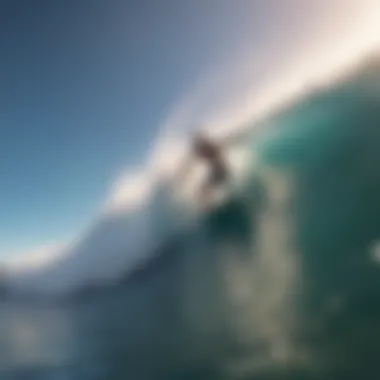

Nevertheless, these projects run the risk of being compromised by conflicting visions or logistical issues, which might not always be easy to navigate. Yet, the essence of collaboration—teaming up for a common goal—remains a quintessential part of surfing culture, encouraging unity even in the light of such challenges.
Influencers and GoPro Culture
Following Trends
In the context of GoPro culture, following trends has become a focal point. Influencers in the surfing community often set the pace by showcasing their skills through visually striking content captured with GoPro devices. These trends inspire countless others to adopt the same approaches, leading to a natural circular flow of influence within the community.
The essential characteristic of following trends is its emphasis on visual storytelling. GoPro cameras provide a dynamic perspective of the surfer’s interaction with the water, effectively allowing others to share in the experience. This visual narrative not only engages the viewers but invites them to actively participate in the culture, either by sharing their own content or joining conversations initiated by influencers.
However, there lies a paradox; while following trends can be invigorating, it might sometimes stifle originality. Surfers might feel pressured to conform to popular styles and ideas, shifting focus from their unique authentic experiences in the water.
Impact of Social Media
The impact of social media resonates deeply with GoPro’s influence in surfing. Platforms like Instagram and TikTok serve as megaphones for individual surfers, amplifying their voices, experiences, and styles. In doing so, social media has transformed how surfing culture is expressed, from lifestyle portrayals to session reports.
The remarkable aspect of social media is its capability to create instant communities and provide visibility to upcoming talent. New surfers can gain fame and recognition almost overnight if their content resonates well with audiences. Given the nature of surfing, this shift towards online representation has fundamentally changed how traditions are shared and celebrated within the community.
However, there are notable disadvantages, including the fleeting attention spans associated with social media. Valuable experiences can be diluted in the quest for likes and shares, detracting from genuine passion for the sport itself. Additionally, the ever-changing algorithms can undermine visibility, leaving surfers feeling frustrated and disheartened.
Challenges of GoPro in Surfboarding
Surfing, a sport steeped in tradition and nature, is evolving with technological integration, notably through devices like GoPro cameras. While the benefits of capturing epic wave-riding moments are undeniable, there are hurdles surfboarders face when incorporating these cameras into their experience. Exploring these challenges not only informs surfers but helps manufacturers refine their products for greater usability. Key elements like technical limitations and environmental considerations play a vital role in influencing how GoPro cameras are perceived and utilized within the surfing community.
Technical Limitations
Water Resistance
One of the most applauded features of GoPros is their water resistance, tailored perfectly for capturing action while immersed in ocean waves. Strongly built to withstand the rigors of saltwater and surf, these cameras boast an impressive ability to function in aquatic environments. However, the extent of water resistance varies among models. For instance, while some entry-level models can tolerate splashes, they might not hold up against full submersion or heavy wave conditions.
The water resistance feature provides a much-needed reassurance for surfboarders; it allows the capturing of exciting moments without the looming dread of damaging expensive equipment. That said, there are notable downsides, such as fogging issues that can occur during temperature changes and the potential for water pressure to damage internal electronics if the camera is not properly sealed.
Battery Drain Issues
Battery life remains a significant concern for GoPro users, especially during long surf sessions. The unique challenge of battery drain issues contributes heavily to the overall experience of capturing surf footage. High-resolution settings, coupled with constant usage of features like Wi-Fi and GPS, rapidly deplete battery resources. One moment you're riding the perfect wave, and the next, the camera's blinking red light informs you that you've got a mere minute left.
Here lies the crucial challenge: surfers need to balance between recording high-quality footage and ensuring their camera can withstand an entire session. The option to carry spare batteries is often impractical due to space constraints. Thus, while GoPro's ease of use and remarkable image quality make it a popular choice, the reality of battery conservation pushes surfers to configure settings carefully—potentially detracting from the spontaneity of the moment.
Environmental Considerations
Preserving Wildlife
When capturing those breathtaking surf shots, it is important to also think about preserving wildlife that exists beneath the surfaces we surf. Using GoPro technology should not come at the expense of respecting ocean life. Devices that can disturb or disrupt natural habitats can lead to a negative impact on delicate marine ecosystems.
A positive aspect of highlighting the ecological responsibility that comes along with surfboarding is the community's increasing awareness of conservation efforts. By promoting responsible usage of GoPro cameras and encouraging surfers to be mindful of their surroundings, the narrative can shift toward preserving the beauty and vitality of ocean habitats.
Wave Impact on Equipment
As surfboards navigate their way through dynamic conditions, the wave impact on equipment becomes an ever-present concern. The relentless force of crashing waves can subject cameras to harsh conditions especially if they are mounted improperly or if they are not adequately protected.
On one hand, wave impact can lead to thrilling footage, capturing the raw energy of the ocean. On the flip side, consistent exposure to heavy surf can chip away at camera integrity. Not all mounts can withstand the same conditions, and constantly battling the elements can result in equipment failures that shift the overall experience from thrilling to frustrating.
Future of GoPro in Surfboarding
The future of GoPro in surfboarding is not just a matter of technological progression; it signifies a profound evolution in how surfers document and share their experiences. As compact cameras become more prevalent within the surfing community, understanding their role becomes increasingly significant. New features, enhanced integrations, and trends can potentially reshape how surf culture is perceived and practiced. The relevance of such advancements can be seen through the lens of innovation, community engagement, and even environmental considerations.
Innovations on the Horizon
Enhanced Features
One of the most exciting aspects of GoPro’s continuation in surfboarding is the enhanced features they keep rolling out in new models. These features often revolve around increasing the quality of footage and the usability of the cameras. For instance, the latest GoPro series has improved image stabilization technology, allowing surfers to capture high-quality video even during the most chaotic wave sequences. This characteristic not only provides aesthetically pleasing results but also serves practical functions for analysis and feedback loops in performance.
A standout unique feature is the ability to shoot in different frame rates, giving surfers flexibility. For example, capturing in slow motion provides viewers with an opportunity to see the intricate details of maneuvers. While this could demand a steeper learning curve for some, the payoff is in creating visually stunning content which resonates with a broader audience.
Integration with Other Technologies
Integration with other technologies is yet another significant aspect of the future of GoPro in surfboarding. As various smart devices continue to permeate our lives, GoPro has been focused on ensuring its cameras seamlessly connect with smartphones and drones. This integration simplifies the sharing of remarkable moments almost instantly, bridging the gap between adventure and audience.
A key feature here is Wi-Fi connectivity, allowing real-time streaming directly to social media platforms. This immediacy caters well to today’s fast-paced content consumption habits. However, there are drawbacks as well: heavy reliance on internet connectivity and battery drain can be potential hurdles during lengthy surf sessions.
Predictions for Surf Culture
Impact on Style
The impact of GoPro technology extends to the overall style of surfing itself. With better cameras enabling high-fidelity visual capture, surfers are increasingly pushed to adopt new and innovative styles of riding waves. This transformation can lead to fresh interpretations of what it means to surf, where aesthetics and technicality become equally celebrated.
Furthermore, alongside the advancement in technology, there’s a rising culture of creativity expressed through various lens styles and shooting techniques. Surfers can showcase their individual flair, making each video a unique art form. However, it’s also essential to remain authentic amidst a wave of possibilities; not every surfer is driven to become an influencer.
Evolving Techniques
As footage quality improves, so too do the techniques surfers use to create and capture their experiences. There is a heightened emphasis on learning new skills, with many now incorporating filming knowledge into their surfing practice. Knowing how to frame a shot, how to capture action, and the importance of timing becomes an integral part of a modern surfer's education.
The unique feature of ongoing learning is manifold; as surfers develop these techniques, they can elevate their performances, not just in how they ride but also how they document these rides. This evolution adds another layer to surf culture, creating a more diverse community of enthusiasts who prioritize both talent and creativity.
Thus, the collaborative spirit in learning these evolving techniques further strengthens bonds within the surf community while encouraging others to join and grow together.
Culmination
The conclusion of this exploration into GoPro integration within the surfboard culture holds significant weight in understanding the overall impact of this technology on the sport and its enthusiasts. In summation, the incorporation of GoPro cameras has altered not just how surfers engage with the waves but also how they share their experiences with the world.
Key Considerations:
- Experience Capture: GoPro cameras have provided surfers with a new medium through which to document their rides; capturing moments that might otherwise be lost in the swell of the sea.
- Sharing the Stoked: The ability to easily share footage on platforms like YouTube and Instagram has transformed every surfer into a potential influencer. This shift has fostered a community driven by visual storytelling.
- Technical Awareness: It's essential for surfers to understand both the capabilities and limitations of GoPro devices. Knowing the right settings and mounts can be the difference between a stellar edit and a frustrating failure.
- Cultural Impact: The rise of GoPro has contributed to the sport's culture by creating a sense of authenticity and connectivity among surfers. Engaging with each other’s footage influences techniques and inspires personalized styles while also bridging geographical gaps.
"The waves don’t just break; they tell stories, and with a GoPro in hand, these tales come to life."
In closing, as this article highlights, while GoPro technology offers a plethora of possibilities for storytelling and sharing, surfers need to be mindful that not everything can be captured perfectly. The essence of surfing lies in the human experience, the feelings behind each wave, and the friendships forged therein. Thus, while the gadgets are a tool for creativity, they should complement, rather than overshadow, the spirit of the sport.
Ultimately, as technologies continue to evolve, surfers are encouraged to embrace the rich tapestry of experiences that each wave brings while utilizing tools like GoPro to enhance, rather than define, their surfing journey.
